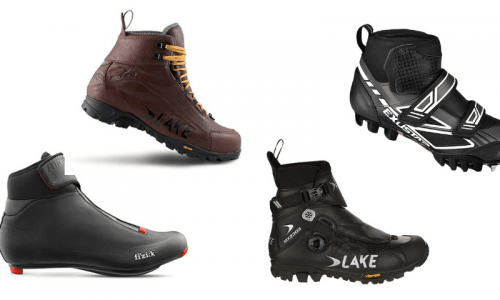Introduction
Folding helmets are designed to be owned and worn by commuters as they are designed to be very compact and lightweight so that they are easy to fit into a rucksack, handbag or just easier to carry in general.
Folding bike helmets vary in styling and practicality, with some folding into your hand but looking less like a usual helmet, while clothes look like any other helmet whilst being slightly larger in their collapsed form.
In this article we’ll look at some of the best folding bike helmets available on the market and give you some tips about choosing the best one for your needs.
Top 4 Folding Bike Helmets
Overade Plixi Fit
One of the smallest folding helmets on the market is the Plixi Fit, which can be found on amazon.com. It is a middle of the range price, and it uses a modular design with hinges to fold the front, middle and back sections together to create a very compact final product.
When folded the “helmet volume is divided by 3”. Unlike some helmets it doesn’t fold flat, so for the businessperson-come-urban-commuter who chooses to carry a briefcase, this may not be the best option for storage, despite its ultra-compact design.
It would be better suited for someone with a slightly larger bag, such as a rucksack as while it takes up arguably less space than a flat helmet, the final shape is better suited to a slightly wider bag.
Furthermore, the mechanism looks slightly too fiddly and complicated for my liking, as (from folded) the top piece folds up, then the back pulls out, then the top unfolds further, then the top locks into the back piece.
While it does allow for a very, very compact folded product, it is more time consuming than other options and in a business or bustling city environment, a complicated folding design is less than desirable.
 The Plixi fit also offers CPSC standard protection, and rugged styling, with the hinges and connectors offering an almost military look to the helmet. The folding mechanism does add some weight over other rigid helmets, with the Plixi weighing 440 grams over most regular helmets at the ~350g mark or less.
The Plixi fit also offers CPSC standard protection, and rugged styling, with the hinges and connectors offering an almost military look to the helmet. The folding mechanism does add some weight over other rigid helmets, with the Plixi weighing 440 grams over most regular helmets at the ~350g mark or less.
As far as comfort features are concerned, the Plixi only has 3 front-facing vents and as a heavier helmet, ventilation would be a concern for me personally, especially whilst it is being used for commuting, where you want to be looking your best for work or a busy day.
The Plixi Fit does redeem itself slightly with the padded chin strap, which is a feature many more expensive helmets can be lacking. The strap is wide and the buckle is around to the side, so it wouldn’t dig into your chin and get uncomfortable which is a nice touch. The piece that holds the helmet on the back of your head has 3 adjustment levels up and down, so it can cater to many head sizes, especially when coupled with the extra pads supplied with the helmet.
Closca Folding Helmet

The next helmet is a flat folding helmet, the Closca folding helmet which can be found on amazon.com like the Plixi Fit. At the time of writing this article it is slightly more expensive than the Plixi Fit, but in my opinion the styling is much more modern and far sleeker.
The Closca uses a modular, three-piece design, like the Plixi Fit but that’s where the similarities end. The Closca is divided horizontally, with the top two pieces folding down into the bottom one, and the bottom of the helmet is flat to create a disc only a couple of inches tall, around the size of a lunchbox.
 This helmet would fit well in a rucksack or flatter bag, such as a laptop bag or handbag, however it doesn’t fold as small as the Plixi Fit. The shape also would take up a significant portion of a flat bags space, but could be slid alongside other flat items such as papers or books without causing a bulge and bending them like the Plixi would likely do. For the commuter use, the flat helmet may be a better option depending on the bag that they wish to use.
This helmet would fit well in a rucksack or flatter bag, such as a laptop bag or handbag, however it doesn’t fold as small as the Plixi Fit. The shape also would take up a significant portion of a flat bags space, but could be slid alongside other flat items such as papers or books without causing a bulge and bending them like the Plixi would likely do. For the commuter use, the flat helmet may be a better option depending on the bag that they wish to use.
The Closca boasts double CPSC and EN1078 safety standards, without compromising on weight or styling. The helmet weighs in at under 300g even for the largest model (as little as 250g for the small size) so the Plixi Fit weighs almost twice as much! The Closca also has an NFC chip implanted into the helmet, which can store your medical and emergency information in the event of a crash.
The Closca has many colours of both the helmet itself and the visor. The base visor is grey on a black or white helmet, which looks modern and slick, especially when combined with the folding mechanism being built into the design of the helmet.
On the downside, the helmet has no front facing vents whatsoever, so despite its lightweight design, it may be uncomfortable, especially over longer commutes and on hotter days when some airflow would definitely be appreciated.
Also, I was disappointed to see that the Closca had no padded strap on the chin, which other, cheaper helmets provide. The Closca does, however, have slightly larger pieces where the straps join under your ears, which would definitely help to keep the straps flush to your face and avoid twisting and tangling, which gets very annoying and frustrating on some helmets.
The company claims to reduce volume by 55% “in less than a second” which is a bold claim. Although this claim is likely an exaggeration, the helmet is very convenient and easy to operate, making it potentially more practical than the Plixi which has far more steps to fold and unfold.
LID folding helmet
On the cheaper end of the folding helmet spectrum, is the LID folding helmet. This helmet is far cheaper than the others, also available on amazon.com (at the time of writing this article.) The LID has 5 segments, split from the front to the back, and the side pieces fold in under the centre arch, mimicking a sort of taco shape when it’s folded. The LID most definitely compromises on looks and folding functionality, as while the Plixi Fit offers a 66% reduction and the Closca offers a 55% reduction in weight, the LID only offers a 33% reduction, with the side pieces folded. This helmet would definitely warrant a rucksack, not a flat bag but is still much smaller than a standard helmet, at a far cheaper price than a lot of alternatives, so it overall is still a valid option.
The LID, like the Closca, has CPSC and EN1078 certification, and also boasts an inbuilt LED light on the rear, which is something that neither of the other two have to offer. They claim a head-turning design, which I suppose could be correct, but maybe not for the reason that they hope.
 The helmet comes in black and white which I don’t think look half-bad. But alongside these options, are Yellow, orange and lime green which, in my opinion are obnoxious and overstated. I do like the simple colours as the design seems minimalist and suits the theme to be modern and innovative but the brighter colours are just too much for my liking.
The helmet comes in black and white which I don’t think look half-bad. But alongside these options, are Yellow, orange and lime green which, in my opinion are obnoxious and overstated. I do like the simple colours as the design seems minimalist and suits the theme to be modern and innovative but the brighter colours are just too much for my liking.
The helmet is also heavier than the Closca, but not the Plixi, as the LID weighs 410 grams for the size medium. This is more than a usual helmet, but with the added functionality, it is to be expected from a cheaper helmet.
What isn’t to be expected is the lack of any attempt to combat the effects of the weight. There are no dedicated vents (although the gaps between the sections may let some airflow in) and on top of this, the straps don’t have the wide adjusters like the other helmets and the buckle sits under the chin without any cushioning.
FEND One foldable helmet

Finally, the FEND One foldable helmet. The Fend One works in a similar way to the LID, in that it has one arch over the top of the helmet and the side pieces fold into it. Just like the LID and the Plixi, the FEND doesn’t fold flat, only smaller, claiming to shrink by 50% when folded.
This means that it still bulges in a bag and again, like the others, could still cause problems when being put into a smaller flat bag with papers and other flat items. As the helmet is likely going to be used by a commuter, I think that this packed-down shape should be considered before purchasing the helmet.
The FEND has the same safety certifications as the other helmets, in fact it “exceeds” the safety specifications for personal commuting vehicles like bikes and scooters under 20mph.
The helmet weighs 400g, around the middle of the field for foldable helmets and has plenty of ventilation, something that doesn’t tend to be seen on some other helmets at this price point. It is more expensive than the LID by some margin, but is similar in price to the other helmets listed.
The helmet boasts an adjustable band at the rear, but the chin clip is centred, which I personally find less comfortable. The straps on the side of your head are wide, so they tangle less easily and there is plenty of room around the ears to avoid rubbing and irritation.
Overall, the FEND is like a more well-rounded version of the LID. It is visibly higher quality but at nearly 4x the price, I wouldn’t be sure if it was worth the extra money if it wasn’t for the excellent ventilation (when compared to the other helmets listed.)
Buying Tips
When looking for a folding helmet I would advise that you look at three major categories.
Comfort
The first is the comfort of the helmet. Look for vents and adjustable straps as well as wider straps with larger clips to keep them flat. Above all else, if you’re looking to buy a folding helmet that could be left in your bag, don’t give yourself a reason to leave it in your bag.
Enjoy wearing it as much as possible. If your head usually sweats when you ride or gets itchy under hats, find a helmet with more vents and one that weighs less as this will mean that you want to wear it and enjoy wearing it.
Safety
The second thing to think about is safety. Is this helmet actually going to protect my head if I fall off? No-one expects to crash their bike, but we all could. Would your helmet actually save you if you needed it to? Does it cover the right places, does it protect the back of your head and the sides.
Where you’re going to ride
 Consider also where you’re going to ride. If you want to ride on big main roads is this sensible to do in a lightweight small helmet or should you invest in a more sturdy, larger helmet.
Consider also where you’re going to ride. If you want to ride on big main roads is this sensible to do in a lightweight small helmet or should you invest in a more sturdy, larger helmet.
Also, check that it has passed standard tests and look at reviews, if someone’s helmet broke when they crashed or if the strap broke after only a month of use, is this really the right helmet to be protecting your head with?
Styling
Finally, styling. To some people this might be number one but let’s be honest, it shouldn’t be. I would much rather be safe and wear a worse looking helmet than choose a sleek helmet that didn’t protect the right spots.
That isn’t to say that you can’t have both, since you most definitely can, it just may set you back slightly more. On a budget, always go for functionality over form, especially when talking about a potentially life-saving piece of equipment.
Conclusion
Overall, I would rather use the Closca, as the straps are nice quality, it has the NFC chip and it overall looks the nicest. Primarily, the safety features on the Closca just look to be the best, it has two safety certifications, is the lightest and stores your emergency information. It combines the sleek, award winning design perfectly with the right safety features for the modern urban commuter.

Tim Hunt is an amateur mountain biker from the Surrey Hills area of England. He has been riding and building for many years in and around the Surrey Hills and loves fast and techy descents!




